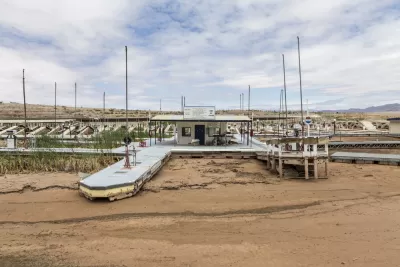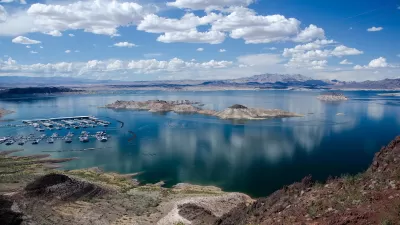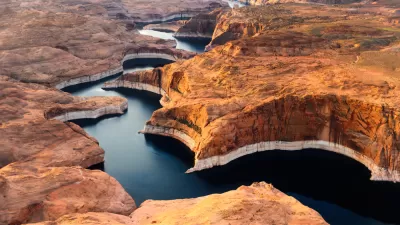Without more immediate, long-term reductions in water demand, Lake Mead and Lake Powell, the West’s most important reservoirs, face imminent collapse.

If Western states don’t make more drastic cuts to water use, Lake Powell and Lake Mead could “collapse,” writes Zak Podmore in the Salt Lake Tribune. “That’s according to a new, peer-reviewed paper published in the journal Science this week that analyzed how current agreements between basin users would fare if the 23-year trend of below-average runoff in the basin continues.”
According to the report, it “is clear that the current drought planning measures won’t cut it alone since the federal government had to enact emergency actions last April to send more water than usual into Lake Powell.”
The paper offers some recommendations based on an analysis of several scenarios. “One of many possible solutions the team identified looked at what would happen to the reservoirs if the Upper Basin states of Utah, Colorado, Wyoming and New Mexico agreed to give up water development ambitions, while the Lower Basin states of California, Arizona and Nevada, along with northwest Mexico, agreed to reductions.” If the Upper Basin limits its water use to 4 million acre-feet per year and the Lower Basin agreed to 2 million acre-feet in cuts per year, the water system could be stabilized.
Kevin Wheeler, lead author of the study, noted that if low-runoff years continue, the situation will become more dire, fast. “Last month, Bureau of Reclamation Commissioner Camille Touton announced that the seven basin states had 60 days to present plans to protect reservoir levels by making between 2 and 4 million acre-feet in water cuts by next year. Touton added that the federal government is prepared to make the reductions if the states cannot agree to a plan.”
The situation has led to tension between regions. While Lower Basin states use twice as much water as their northern neighbors, numerous projects proposed in Upper Basin states would increase their water demand. According to Wheeler, “water managers should be planning for a possible continuation of the Millennium Drought, which has reduced Colorado River flows by an average of 20% compared to the previous century’s average.”
Earlier this year, experts warned that the water level in Lake Powell had dropped to within 33 feet of the critical minimum needed to continue producing electricity.

Study: Maui’s Plan to Convert Vacation Rentals to Long-Term Housing Could Cause Nearly $1 Billion Economic Loss
The plan would reduce visitor accommodation by 25,% resulting in 1,900 jobs lost.

North Texas Transit Leaders Tout Benefits of TOD for Growing Region
At a summit focused on transit-oriented development, policymakers discussed how North Texas’ expanded light rail system can serve as a tool for economic growth.

Using Old Oil and Gas Wells for Green Energy Storage
Penn State researchers have found that repurposing abandoned oil and gas wells for geothermal-assisted compressed-air energy storage can boost efficiency, reduce environmental risks, and support clean energy and job transitions.

Private Donations Propel Early Restoration of Palisades Playground
Los Angeles has secured over $1.3 million in private funding to restore the Pacific Palisades playground months ahead of schedule, creating a modern, accessible space that supports community healing after recent wildfires.

From Blight to Benefit: Early Results From California’s Equitable Cleanup Program
The Equitable Community Revitalization Grant (ECRG) program is reshaping brownfield redevelopment by prioritizing projects in low-income and environmental justice communities, emphasizing equity, transparency, and community benefits.

Planting Relief: Tackling Las Vegas Heat One Tree at a Time
Nevada Plants, a Las Vegas-based nonprofit, is combating the city’s extreme urban heat by giving away trees to residents in underserved neighborhoods, promoting shade, sustainability, and community health.
Urban Design for Planners 1: Software Tools
This six-course series explores essential urban design concepts using open source software and equips planners with the tools they need to participate fully in the urban design process.
Planning for Universal Design
Learn the tools for implementing Universal Design in planning regulations.
Ascent Environmental
Borough of Carlisle
Institute for Housing and Urban Development Studies (IHS)
City of Grandview
Harvard GSD Executive Education
Toledo-Lucas County Plan Commissions
Salt Lake City
NYU Wagner Graduate School of Public Service





























